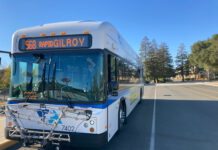An only child and an only grandchild my summers were spent at my grandparent’s avocado and lemon ranch in Carpinteria. It was the late ‘50s and early ‘60s when the California water projects were in full swing and my grandfather, Cliffford “Brad” Bradbury, a Santa Barbara County supervisor and member of the California State Water Board, had become anointed by Gov. Goodwin Knight to negotiate the federal funding and development of the water projects in Washington DC.
I heard about the projects and saw the development and construction of Cachuma, Tehachape and other major projects at my grandfather’s side. At the time, the water projects were the most significant public works projects to have been completed in the world. The future view was that by 2020, the design of 12 million acre feet would accommodate the entire state.
It is hard to imagine with that forward thinking and vision that the unthinkable could happen and that California would be using 42-plus million acre feet per year. The original design for all of the projects is just slightly more than a quarter of what will be needed just to meet this year’s minimum. Given this history, it is important to review the construction proposed and underway.
As we look to construct more than 5,000 dwelling units in Morgan Hill and South Valley, I reference the estimated water use calculation of 85 gallons per person per day, 340 gallons per day per family of four extrapolated to 1.7 million gallons per day for 5,000 DU. For the year, that is 620,500,000 gallons of water above our current consumption in Morgan Hill.
Visualize this: almost 2,000 acre feet, which translates to about three square miles. For reference, in Morgan Hill it is one mile from the library to the train tracks. Morgan Hill is completely dependent on groundwater for all of our water needs. Below our dry crust every year we will lose an additional one foot depth of water over 3-plus square miles to new residential use.
I am an architect and I have done some development. When I did the math, it astounded me. This is where the word sustainable has validity. We as a community cannot survive without addressing our long-term water needs; a complete analysis of projected water use contrasted with our existing aquifer capacity is imperative prior to the approval of any new major residential development.
We need to tell Sacramento that following SB330 and forcing development may result in subsidence and immediate irreversible damage to our natural aquifers. The long-term repercussion is that once our aquifers collapse they can not be recharged. We need to take the time for analysis first and ask for assistance from the Santa Clara Valley Water District to help us think through this. It is only with actual data that we can understand how to think about the future.
Lesley L. Miles AIA, LEED AP
President, Weston Miles Architects








